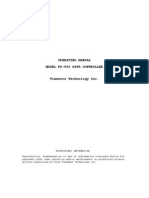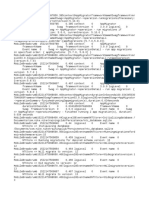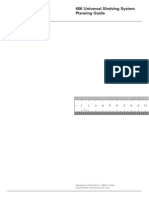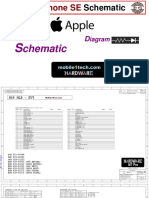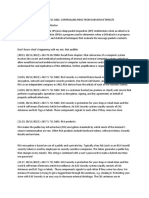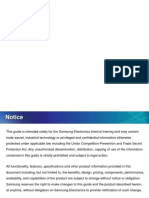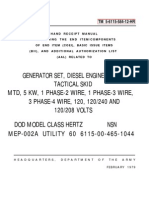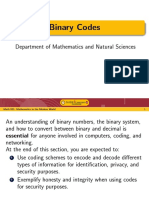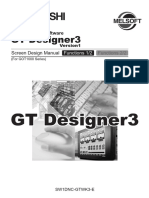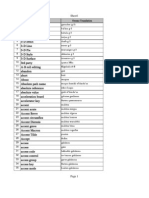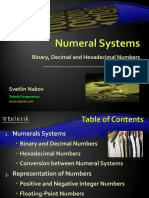The American Standard Code For Information Interchange
The American Standard Code For Information Interchange
Uploaded by
Ciucur Mircea MihaiCopyright:
Available Formats
The American Standard Code For Information Interchange
The American Standard Code For Information Interchange
Uploaded by
Ciucur Mircea MihaiOriginal Title
Copyright
Available Formats
Share this document
Did you find this document useful?
Is this content inappropriate?
Copyright:
Available Formats
The American Standard Code For Information Interchange
The American Standard Code For Information Interchange
Uploaded by
Ciucur Mircea MihaiCopyright:
Available Formats
The American Standard Code for Information Interchange (ASCII), is a character-encoding scheme based on the ordering of the English
alphabet. ASCII codes represent text in computers, communications equipment, and other devices that use text. Most modern characterencoding schemes are based on ASCII, though they support many more characters than did ASCII. Historically, ASCII developed from telegraphic codes. Its first commercial use was as a seven-bit teleprinter code promoted by Bell data services. Work on ASCII formally began October 6, 1960, with the first meeting of the American Standards Association's. The first edition of the standard was published during 1963, a major revision during 1967, and the most recent update during 1986. Compared to earlier telegraph codes, the proposed Bell code and ASCII were both ordered for more convenient sorting of lists, and added features for devices other than teleprinters. ASCII includes definitions for 128 characters: 33 are nonprinting control characters (now mostly obsolete) that affect how text and space is processed; 94 are printable characters, and the space is considered an invisible graphic.The most commonly used character encoding on the World Wide Web was US-ASCII until December 2007, when it was surpassed by UTF-8. Binary Ab Oct Dec Hex br 0 00 NU L SO H
[t 1] [t 2] [t 3]
000 0110 006
06 ACK
^F
Acknowledgment
000 0111 007
07 BEL
^G
\a
Bell
000 1000 010
08
BS
^H
\b
Backspace
[t 4][t 5]
000 1001 011
09
HT
^I
\t
Horizontal Tab
[t 6]
000 1010 012 10
0A
LF
^J
\n
Line feed
000 1011 013 11
0B
VT
^K
\v
Vertical Tab
000 1100 014 12
0C
FF
^L
\f
Form feed
[t 7]
Description Null character
000 1101 015 13
0D
CR
^M
\r
Carriage return
000 0000 000
^@
\0
000 1110 016 14
0E
SO
^N
Shift Out
000 0001 001
01
^A
Start of Header
000 1111 017 15
0F
SI
^O
Shift In
000 0010 002
02 STX
^B
Start of Text
001 0000 020 16
10 DLE DC 1 DC 2 DC 3 DC 4
^P
Data Link Escape Device Control 1 (oft. XON) Device Control 2 Device Control 3 (oft. XOFF) Device Control 4
000 0011 003
03 ETX
^C
End of Text
001 0001 021 17
11
^Q
000 0100 004
04 EOT EN Q
^D
End of Transmission
001 0010 022 18
12
^R
000 0101 005
05
^E
Enquiry
001 0011 023 19
13
^S
001 0100 024 20
14
^T
1 0101 025 21
15 NAK
^U
Negative Acknowledge ment Synchronous Idle End of Transmission Block Cancel End of Medium Substitute
001 0110 001 0111 001 1000 001 1001 001 1010 001 1011 001 1100 001 1101 001 1110 001 1111
026 22
16 SYN
^V
027 23
17
ETB
^W
030 24
18 CAN
^X
031 25
19
EM
^Y
032 26 1A SUB
^Z
033 27
1B
ESC
^[
\e
[t 8]
Escape
[t 9]
1. ^ The Unicode characters from the area U+2400 to U+2421 reserved for representing control characters when it is necessary to print or display them rather than have them perform their intended function. Some browsers may not display these properly. 2. ^ Caret notation often used to represent control characters. This also indicates the key sequence to input the character traditionally on most text terminals: The caret (^) that begins these sequences represents holding down the "Ctrl" key while typing the second character. 3. ^ Character Escape Codes in C programming language and many other languages influenced by it, such as Java and Perl (though not all implementations necessarily support all escape codes). 4. ^ The Backspace character can also be entered by pressing the "Backspace", "Bksp", or key on some systems. 5. ^ a b The ambiguity of Backspace is due to early terminals designed assuming the main use of the keyboard would be to manually punch paper tape while not connected to a computer. To delete the previous character you had to back up the paper tape punch, which for mechanical and simplicity reasons was a button on the punch itself and not the keyboard, then type the rubout character. They therefore placed a key producing rubout at the location used on typewriters for backspace. When systems used these terminals and provided command-line editing, they had to use the "rubout" code to perform a backspace, and often did not interpret the backspace character (they might echo "^H" for backspace). Other terminals not designed for paper tape made the key at this location produce Backspace, and systems designed for these used that character to back up. Since the delete code often produced a backspace effect, this also forced terminal manufacturers to make any "Delete" key produce something other than the Delete character. 6. ^ The Tab character can also be entered by pressing the "Tab" key on most systems. 7. ^ The Carriage Return character can also be entered by pressing the "Return", "Ret", "Enter", or key on most systems. 8. ^ The '\e' escape sequence is not part of ISO C and many other language specifications. However, it is understood by several compilers. 9. ^ The Escape character can also be entered by pressing the "Escape" or "Esc" key on some systems. 10. ^ ^^ means Control-Caret (pressing the "Ctrl" and "^" keys), not Control-Control. 11. ^ The Delete character can sometimes be entered by pressing the "Backspace", "Bksp", or key on some systems.
034 28
1C
FS
^\
File Separator Group Separator Record Separator
035 29 1D
GS
^]
036 30
1E
RS
^^
[t 10]
037 31
1F
US
^_
Unit Separator
111 1111
177 127 7F
DEL
^?
Delete
[t 11][t 5]
Binary
Oct Dec Hex 20 21 22 23 24 25 26 27 28 29 2A 2B 2C
Gly ph ! " # $ % & ' ( ) * + , . / 0 1 2 3 4 5 6 7 8
011 1001 071 57 011 1010 072 58 011 1011 073 59 011 1100 074 60
39 3A 3B 3C
9 : ; < = > ?
Binary
Oct Dec Hex Glyph 60 61 62 63 ` a b c d e f g h i j k l m n o p q r s t u v w x y z 101 1011 133 91 101 1100 134 92 5B 5C [ \ ] ^ _
110 0000 140 96 110 0001 141 97 110 0010 142 98 110 0011 143 99
010 0000 040 32 010 0001 041 33 010 0010 042 34 010 0011 043 35 010 0100 044 36 010 0101 045 37 010 0110 046 38 010 0111 047 39 010 1000 050 40 010 1001 051 41 010 1010 052 42 010 1011 053 43 010 1100 054 44
101 1101 135 93 5D 101 1110 136 94 101 1111 137 95 5E 5F
011 1101 075 61 3D 011 1110 076 62 011 1111 077 63 3E 3F
110 0100 144 100 64 110 0101 145 101 65 110 0110 146 102 66 110 0111 147 103 67 110 1000 150 104 68 110 1001 151 105 69 110 1010 152 106 6A 110 1011 153 107 6B 110 1100 154 108 6C 110 1101 155 109 6D 110 1110 156 110 6E 110 1111 157 111 6F 111 0000 160 112 70 111 0001 161 113 71 111 0010 162 114 72 111 0011 163 115 73 111 0100 164 116 74 111 0101 165 117 75 111 0110 166 118 76 111 0111 167 119 77 111 1000 170 120 78 111 1001 171 121 79 111 1010 172 122 7A
010 1101 055 45 2D 010 1110 056 46 010 1111 057 47 011 0000 060 48 011 0001 061 49 011 0010 062 50 011 0011 063 51 011 0100 064 52 011 0101 065 53 011 0110 066 54 011 0111 067 55 011 1000 070 56 2E 2F 30 31 32 33 34 35 36 37 38
Binary
Oct Dec Hex Glyph 40 41 42 43 44 45 46 47 48 49 @ A B C D E F G H I J K L M N O P Q R S T U V W X Y Z
100 0000 100 64 100 0001 101 65 100 0010 102 66 100 0011 103 67 100 0100 104 68 100 0101 105 69 100 0110 106 70 100 0111 107 71 100 1000 110 72 100 1001 111 73
100 1010 112 74 4A 100 1011 113 75 100 1100 114 76 4B 4C
100 1101 115 77 4D 100 1110 116 78 100 1111 117 79 101 0000 120 80 101 0001 121 81 101 0010 122 82 101 0011 123 83 101 0100 124 84 101 0101 125 85 101 0110 126 86 101 0111 127 87 101 1000 130 88 101 1001 131 89 4E 4F 50 51 52 53 54 55 56 57 58 59
101 1010 132 90 5A
You might also like
- Buypass 31240B Base53.40.00Document85 pagesBuypass 31240B Base53.40.00Burn Na1No ratings yet
- DC-07 Going Through SIA Public ReviewDocument45 pagesDC-07 Going Through SIA Public ReviewkalpeshbrNo ratings yet
- Corona2Inspect TranscriptDocument6 pagesCorona2Inspect TranscripttrashbinfoodieNo ratings yet
- Toshiba Tecra Portege Qosmio Libretto Bios Password Unlock GuideDocument4 pagesToshiba Tecra Portege Qosmio Libretto Bios Password Unlock GuideLaptop Rebirth50% (2)
- Direct Merchant NotificationDocument9 pagesDirect Merchant NotificationguclubabaNo ratings yet
- CYBERCRiME 11 08 19Document287 pagesCYBERCRiME 11 08 19Pavăl SebastianNo ratings yet
- Galaxy Programming ManualDocument190 pagesGalaxy Programming ManualLeopardLapatrat0% (1)
- 12 Mercedes 300 Carstar Shop InvoiceDocument2 pages12 Mercedes 300 Carstar Shop InvoiceSebastian Almaraz UnzuetaNo ratings yet
- AEA PK-900 ManualDocument325 pagesAEA PK-900 ManualScott Gillis100% (1)
- Introduction To C#Document398 pagesIntroduction To C#api-3729173No ratings yet
- Cure Information SVNCDocument45 pagesCure Information SVNCKawadasanNo ratings yet
- InstallDocument29 pagesInstallAleksxanderGovaNo ratings yet
- Assgni 1 (MIS)Document3 pagesAssgni 1 (MIS)Areeba NaheedNo ratings yet
- Extract Hidden Data From PDFDocument2 pagesExtract Hidden Data From PDFNicoleNo ratings yet
- Michael E. McKinzy, Sr. - The 2024 Presidential National Medal Technology and Innovation NominationList 10 Submitter 5-03-2024Document18 pagesMichael E. McKinzy, Sr. - The 2024 Presidential National Medal Technology and Innovation NominationList 10 Submitter 5-03-2024michael_sr_44No ratings yet
- World Gold Holdings August 2022Document2 pagesWorld Gold Holdings August 2022world.of.ledgersNo ratings yet
- CDGGGDocument38 pagesCDGGGmarioNo ratings yet
- RJ 5190Document74 pagesRJ 5190Iman SusiloNo ratings yet
- Zytel® 70G30HSLR BK099Document4 pagesZytel® 70G30HSLR BK099srinivasaNo ratings yet
- Manual 606 Universal Shelving System Planning GuideDocument19 pagesManual 606 Universal Shelving System Planning GuideJrg LpzNo ratings yet
- MX800 Programmers GuideDocument344 pagesMX800 Programmers GuideChristian Alberto Soto MullerNo ratings yet
- Debug Card Manual 1 PDFDocument29 pagesDebug Card Manual 1 PDFPavel PetrescuNo ratings yet
- Section 25 - GFC 332 Gas Flow ComputerDocument30 pagesSection 25 - GFC 332 Gas Flow ComputerhammamiNo ratings yet
- Office SerialsDocument10 pagesOffice SerialsGhoparsNo ratings yet
- Sec7 E90-92-93 M3 Optnl-EquipDocument4 pagesSec7 E90-92-93 M3 Optnl-Equipjoker63000No ratings yet
- Iphone SEDocument61 pagesIphone SEEduardo GómezNo ratings yet
- Pump Flow - TestDocument8 pagesPump Flow - TestrouxlioNo ratings yet
- E 93 HardtopDocument46 pagesE 93 HardtopTang HeronNo ratings yet
- Unblock LinksDocument2 pagesUnblock LinksKingston NorrisNo ratings yet
- Programming Remote For AlarmDocument6 pagesProgramming Remote For AlarmAaron IbrahimNo ratings yet
- Liccert PDFDocument59 pagesLiccert PDFMurasaki MonogatariNo ratings yet
- 2014 DrivelineAxle Propeller Shaft - Encore and TraxDocument16 pages2014 DrivelineAxle Propeller Shaft - Encore and Traxalberto navasNo ratings yet
- Automated Teller Machine Using C++Document76 pagesAutomated Teller Machine Using C++S BOSENo ratings yet
- isa纸Document6 pagesisa纸hhtdxiwlf100% (2)
- Durando 2000 4.7 PDFDocument5 pagesDurando 2000 4.7 PDFAlejandro men MendozaNo ratings yet
- General Nokia Secret Codes For All Phones: Consulting Contact Us Advertise Here Write For UsDocument6 pagesGeneral Nokia Secret Codes For All Phones: Consulting Contact Us Advertise Here Write For UsAmin KhanNo ratings yet
- EAS TagsDocument5 pagesEAS TagsShame BopeNo ratings yet
- Cat 2-159 NPDocument158 pagesCat 2-159 NPomanfastsolutionNo ratings yet
- Advanced Occupant Detection System PDFDocument92 pagesAdvanced Occupant Detection System PDFfelixsafar3243No ratings yet
- 48V Scooter 337068-121168Document1 page48V Scooter 337068-121168ADIDAS ADIDASNo ratings yet
- Electrak Underfloor To Workstation PDFDocument56 pagesElectrak Underfloor To Workstation PDFMekaNo1DNo ratings yet
- Welcome!: 2009 3 Series, Advanced Diesel & New Idrive TrainingDocument71 pagesWelcome!: 2009 3 Series, Advanced Diesel & New Idrive Trainingjoker63000100% (1)
- Snap PatentDocument21 pagesSnap PatentCharles GrossNo ratings yet
- Instant Brands 11Document38 pagesInstant Brands 11Ann DwyerNo ratings yet
- Cyber Security RecordDocument33 pagesCyber Security RecordAli AhammadNo ratings yet
- Compliance Check TankDocument9 pagesCompliance Check TankHooman ParsaNo ratings yet
- County of Santa Clara Local Rules of Court 2022Document118 pagesCounty of Santa Clara Local Rules of Court 2022Daya BaranNo ratings yet
- Ranger 2000-2001Document32 pagesRanger 2000-2001testNo ratings yet
- Catalog OnityDocument28 pagesCatalog OnitySimonIngantaPurbaNo ratings yet
- JDocument109 pagesJMiguel ChavezNo ratings yet
- Night Owl Connect CMS Manual - EnglishDocument59 pagesNight Owl Connect CMS Manual - EnglishjimNo ratings yet
- SM Hard TestDocument34 pagesSM Hard TestNico Nicolata LópezNo ratings yet
- Techline Connect User - GuideDocument26 pagesTechline Connect User - Guidecarl robinsonNo ratings yet
- DRAMs ProDocument2 pagesDRAMs ProzokiNo ratings yet
- Know All System Folders in Symbian PhonesDocument5 pagesKnow All System Folders in Symbian Phonesjelenjek83No ratings yet
- Fail SafeDocument9 pagesFail SafeBahiru BtNo ratings yet
- 5k Generator Manual Hand-Receipt-ManualDocument10 pages5k Generator Manual Hand-Receipt-ManualJeff TaulbeeNo ratings yet
- Black Book SoftDocument77 pagesBlack Book SoftSiddiqui AlmasNo ratings yet
- TDocument38 pagesTgauravsharmacl2007No ratings yet
- Programming: ASCII Control CodesDocument2 pagesProgramming: ASCII Control CodesVictor PaulNo ratings yet
- Delphi - Technical Reference Card 7.210Document2 pagesDelphi - Technical Reference Card 7.210naxo128No ratings yet
- ASCII Character SetDocument4 pagesASCII Character SetNagarajPRNo ratings yet
- Data Representation in Computers PDFDocument33 pagesData Representation in Computers PDFCBAKhanNo ratings yet
- Laumas W100Document81 pagesLaumas W100JOSENo ratings yet
- QB CP03 EngDocument23 pagesQB CP03 EngPoon Yin KwongNo ratings yet
- Project Assignment Computer Science - Final - 2013 - VijayDocument17 pagesProject Assignment Computer Science - Final - 2013 - VijayMehul SrivastavaNo ratings yet
- CP441 eDocument250 pagesCP441 ebbudhdevNo ratings yet
- Binary Arithmetic and CodesDocument16 pagesBinary Arithmetic and Codeskarisaj415No ratings yet
- Interfacing To A Graphics Module With A Toshiba T6963C ControllerDocument6 pagesInterfacing To A Graphics Module With A Toshiba T6963C ControllerElenilson SampaioNo ratings yet
- 4Document17 pages4endrisNo ratings yet
- CodingDocument21 pagesCodingMaxpein Del ValleNo ratings yet
- Meiligao GPRS Communication Protocol GT30i GT60 VT300 VT310 VT400 V2.1Document24 pagesMeiligao GPRS Communication Protocol GT30i GT60 VT300 VT310 VT400 V2.1bsicc2007No ratings yet
- Compuprint SP40 Programmer Manual PDFDocument288 pagesCompuprint SP40 Programmer Manual PDFMorteza JalalyNo ratings yet
- ASCIIDocument20 pagesASCIIJennylyn DionecioNo ratings yet
- Chapter 1 Digital Systems and Binary NumbersDocument13 pagesChapter 1 Digital Systems and Binary NumbersSana NazirNo ratings yet
- C Assignment NewDocument35 pagesC Assignment NewShreta MukherjeeNo ratings yet
- Assignment On EDIDocument58 pagesAssignment On EDIAaqueeb Pasha100% (1)
- Ascii Table For Cyrillic Charset (CP855) - Ascii-CodesDocument3 pagesAscii Table For Cyrillic Charset (CP855) - Ascii-CodesMarija Milosavljevic-LjubicNo ratings yet
- GT Designer3 Version1 Screen Design Manual (Functions)Document1,304 pagesGT Designer3 Version1 Screen Design Manual (Functions)antonioNo ratings yet
- Mwa Asi1159Document28 pagesMwa Asi1159cezarbtNo ratings yet
- Representation of Data - RevisionDocument20 pagesRepresentation of Data - RevisiongexyszNo ratings yet
- English AfanOromoGlossaryDocument81 pagesEnglish AfanOromoGlossarymo430ka100% (3)
- Chapter 1Document10 pagesChapter 1Moon LytNo ratings yet
- Numeral Systems: Binary, Decimal and Hexadecimal NumbersDocument26 pagesNumeral Systems: Binary, Decimal and Hexadecimal NumberstesfuNo ratings yet
- Access Serial Ports With Visual BasicDocument10 pagesAccess Serial Ports With Visual BasicFrederico De CarvalhoNo ratings yet
- Lab 6: Ciphers and Digital CertificatesDocument9 pagesLab 6: Ciphers and Digital CertificatesmNo ratings yet
- KHB Can BusDocument5 pagesKHB Can BusGIRINITH RNo ratings yet
- ASCII - Full ListDocument4 pagesASCII - Full ListFrancisc GeorgeNo ratings yet
- Lec 3Document33 pagesLec 3Ahmet ArabNo ratings yet
- Lesson 1.1.3a Resource - Worksheet 3 Data Storage (Text)Document3 pagesLesson 1.1.3a Resource - Worksheet 3 Data Storage (Text)technabooksNo ratings yet








